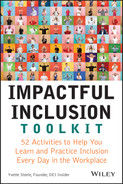Foreword
The explosive growth in interest of the diversity, equity, and inclusion field over the years is unsurprising to many, particularly as we all have watched a number of events across the globe that highlight the continued oppression of marginalized groups. From the waves of anti-Black and anti-Asian violence to the promulgation of laws authored with the intent of excluding the LGBTQ+ community, examples of inequitable and exclusionary practices are many. It is this collective societal reckoning with diversity and our complicated history with various identities that has driven this wave of investment in new DEI programs and business functions.
Yet even with an abundance of new DEI certification programs and the like, we as practitioners still find ourselves faced with a familiar set of questions from those who are looking to apply these principles to their daily lives: What do I do? How do I make a difference? How do I demonstrate my commitment to DEI and to people who are different from me?
It's a persistent set of questions that practitioners like me in the corporate space face regularly. While these questions generally come from a place of genuine curiosity, I also acknowledge that they are often driven by fear. Many people do not want to mistreat those around them and certainly fear the perception of being any type of “ist” in a world where what has been labeled as “cancel culture” (also known as accountability) has found prominence. Still, these questions persist not because the tools we provide are impractical or even extremely difficult to apply. Rather, it's usually because there is additional foundational, introspective work that the learner must do, and worse yet, there is little to no instant gratification. Transformational change at both the individual and corporate levels takes time and consistent investment. The flawed view that one can just call themselves an ally because they have that one gay friend or they stopped a woman from being interrupted in a meeting that one time is just not going to cut it. Learners and organizations alike must actually unlearn behaviors and practice new and inclusive behaviors to the point where they become habitual and normal.
Learning in the DEI space is plagued with cursory modules that focus only on anti-harassment and compliance, especially as it relates to the workplace. Don't misunderstand me here; the content of those modules is important and should be used to continue to address some of the ills of toxic and noninclusive corporate cultures. But that alone does not speak to the everyday needs of a learner or give them the opportunity to think about the ways that identity impacts how they navigate the world. More important, most corporate diversity training does not provide learners with the opportunity for ongoing practical application.
It is in this gap where the author finds her audience. Yvette Steele grounds her work in both authenticity and practicality for the reader. Her authenticity—and of course her ability to sell me an idea—is what sparked our connection years ago. She has been a great collaborator and partner as I have taken on more expansive roles building both the DEI and environmental, social, and governance business functions in global Silicon Valley tech organizations. I have been an excited supporter and observer—and hopefully somewhat helpful—as she has really turned her focus to diversity, equity, and inclusion work. Leveraging her own personal journey, multiplicity of identities, and investment in learning inclusive and equitable practices, she takes the reader on a journey that begins with self-awareness and leads them to behavioral changes.
As you move through the activities herein, you are not so subtly encouraged to pause, reflect, and even role-play—to really think about what you would do in any of these scenarios. And that is coupled with small yet impactful actions that individuals can take in the course of their daily lives to effect change. She encourages you to take this in small bites, focusing on a couple of activities at a time and doing the necessary reflective work to truly understand what you read and what it looks like in practice. If you are a seasoned practitioner in this space, this book is rightfully not written for you. This is for those who have found themselves looking for ways to get started on a personal journey of re-learning.
It is important to note for any work focused on DEI practices that things change over time. As people become more comfortable identifying themselves in various ways both in and out of the workplace, and societal norms change, so too will these scenarios and activities. That makes this a great, living piece that can be revisited and offers readers the chance to also examine the field's growth over time alongside your personal development. Stay the course, dear reader. The journey is a long and difficult one, and you are given a great guide to help you along the way.
Ulysses J. Smith
Global DEI strategist and executive
